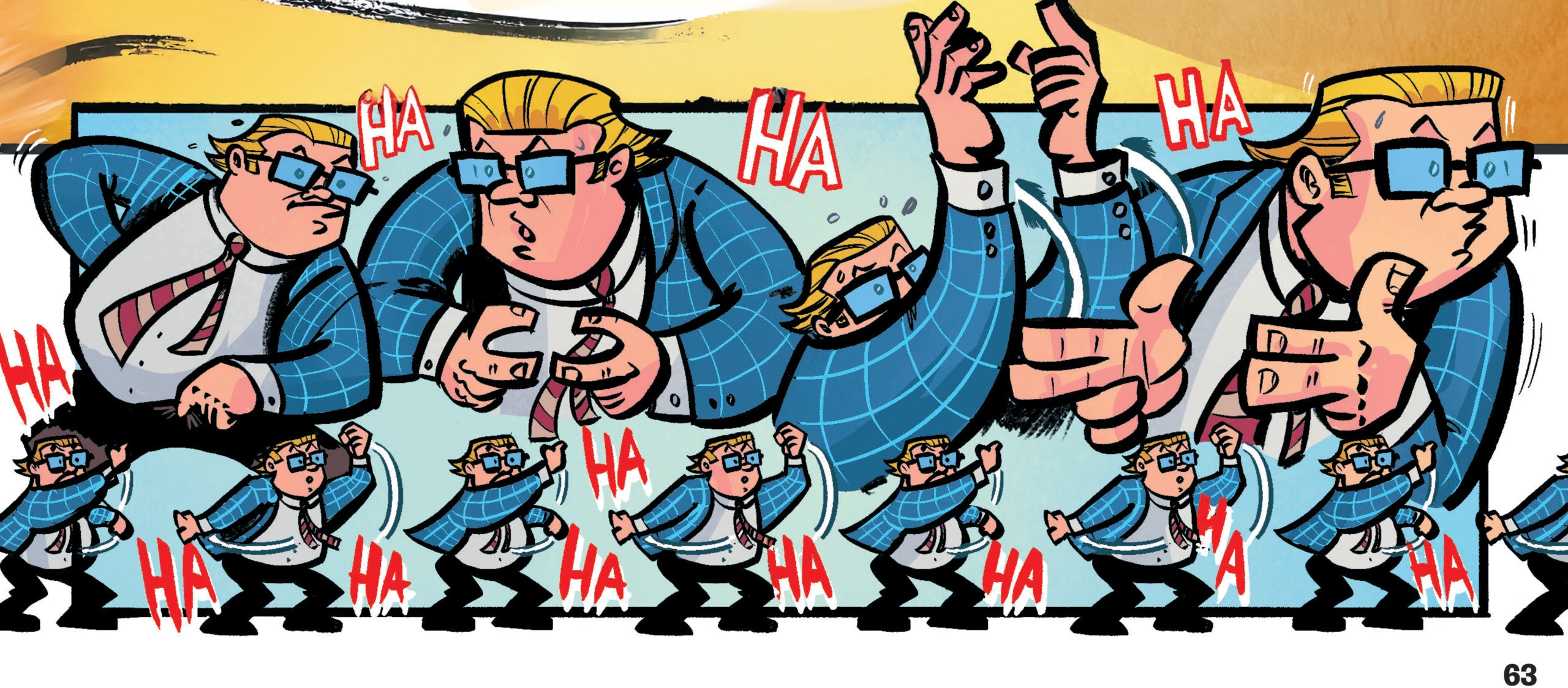Author Mike Sacks on the art of writing comedy. Also, TV critics Matt Zoller Seitz and Alan Sepinwall reflect on the prestige TV series, “Mad Men.” And music blogger Joshua Farber tells us why he loves cover versions.
Featured in this Show
-
What Comedy Writers Talk About When They Talk About Comedy
Mike Sacks is the author of “Poking a Dead Frog: Conversations with Today’s Top Comedy Writers.”
The title comes from E.B. White’s famous quote, “Explaining a joke is like dissecting a frog. You understand it better but the frog dies in the process.”
It’s safe to say that no frogs were harmed in the making of Sacks’ book, which features entertaining and enlightening conversations with many of today’s greatest comedy writers, including: Mike Schur, the creator of the hit TV shows “Parks and Recreation” and “The Good Place;” comedy legend Mel Brooks; and The Onion writer Carol Kolb.
Sacks told WPR’s “BETA” that the perception that comedy writers are miserable is indeed true, but they’re not alone.
“The thing is though that everyone’s miserable,” Sacks said. “But we just happen to hear about it from comedy writers. If you were to go into your dentist, he’d be miserable. But his job is not to tell you jokes about his relationship with his wife is breaking up.”
Sacks said he doesn’t know if comedy writers are more miserable than people who have other occupations. But he does think there’s a strong connection between depression, anxiety and obsessive compulsive disorder (OCD) in comedy. He said there’s an especially strong correlation between OCD and comedy. He only asked writers about OCD because he too suffers from it.
“I would say about 75 percent suffer from symptoms of obsessive compulsive disorder. But what’s interesting is a lot of these writers use that compulsion, that feeling of compulsion, to write, to write every day,” Sacks said. “And because of that, it sort of feeds into their success. So they funnel that energy, rather than washing their hands or licking light poles or whatever, they funnel that obsessiveness into having to write every day. And if they don’t, they get anxious. So it’s not a pleasant way to live necessarily, but they’ve taken the best of a bad situation and have made the best of it.”
So is there an upside to having OCD if you work in comedy, especially as a standup comedian because you’re constantly making small but important changes to your jokes and fine-tuning them over and over again in front of different audiences?
“Oh, definitely,” Sacks said. “You absolutely do need an obsessiveness. And what’s interesting too is even someone like Mel Brooks, whom I interviewed, you still sense that he’s obsessive, even with all the accomplishments he has achieved, he’s still obsessive about working and getting the laugh, which I found fascinating. So for him, it was never about money, it was never about anything but producing laughs and writing comedy and performing comedy. And he still feels the same way.”
One of the things that really defines great comedy is the element of surprise.
Comedian, actor and filmmaker Albert Brooks once said that “to me, the whole point of comedy is just to go crazy and try things that are as wild as your brain can think of, and do them again if they don’t work. Do them again. Believe me, the audience comes to you.”
Andy Kaufman would serve as the perfect spokesmodel for this idea. Yet it seems that there are certain standard comedy tropes that people find inherently funny. So how does Sacks think that comedians and comedy writers find a balance between the element of surprise and freshness while still delivering the funniness?
That’s the big question, Sacks said. The jokes that can be found in the plays of the ancient Greek comic playwright Aristophanes form the bedrock of modern comedy — jokes about such subjects as human behavior, sex and bodily functions.
“So there’s only so crazy one can get. I mean, these jokes have to be tethered to human behavior, and we’re all wired to recognize certain human behavior. So it’s a matter of working within that framework while also standing out. That’s the real trick,” Sacks said. “Now what’s interesting is Albert Brooks is a genius and his standup was absolutely amazing.”
“But the problem with that sometimes is that you can be ahead of your time, (as he was) with both his movies and his standup. So it’s also a matter of not just putting good work out there that works within the framework, that’s different from anyone else,” he continued. “It’s also timing. And to be too ahead of your time sometimes, especially when it comes to comedy, is not necessarily a good thing for your career. It can be a very frustrating career.”
Steve Martin wrote in his memoir, “Born Standing Up,” about being willing to try weird material when he first started doing standup and to make it clear to his audiences that he thought this material was hilarious.
“That was a rare case of him doing what he wanted to do, doing it very differently and hitting huge. He would fill stadiums,” Sacks said. “Very, very, very rare. I don’t know of any other case like that. I mean, Richard Pryor eventually, but that took years after he had changed his act. But Steve Martin, it comes down to, I think, the fact he’s just brilliant. And the writing’s phenomenal, as was the performance.”
Sacks also talked to Tom Scharpling about his radio show, “The Best Show on WFMU,” which aired on the independent community radio station WFMU from 2000 to 2013.
Scharpling’s radio show featured long-form comedy, sketches that could last as long as 30 minutes, 45 minutes or even an hour.
“It really reminds me of a modern Bob and Ray in the sense that Tom would play records, he would take calls,” Sacks said. “And every show, or most shows, he would receive a call from a character played by Jon Wurster, who’s also an amazing drummer for Bob Mould and Superchunk and The Mountain Goats. Brilliant guy.”
Wurster played characters like an insufferable, arrogant record store owner and a 63-year-old hoodlum/author who considers himself to be “The Real-Life Fonzie.”
“The radio audience would not know this was a put-on. He would go on for 15, 20 minutes, take calls, incense the callers,” Sacks said. “Tom would play off him, Tom was a great straight man. And they would just create this world. And they created a world called Newbridge, which was an imaginary town in New Jersey. This town almost became like the ‘Simpsons’ town in that there were hundreds of characters, there were direct relations between certain characters. It was a history of Newbridge.”
“And over the years, like a very, very strange Lake Wobegon, it just grew and grew and grew. It became a cult favorite among top comedy writers,” he continued.
“Writers from late-night shows, sitcoms, standups, they would tune in each week to hear this show. It was very much a show that was working at the top of its level. It didn’t care about ratings and was very, very smart, which I think appealed to these comedy writers,” he said. “It reminded me of the free-form jazz clubs that would take place in the ’50s or ’60s where anything went. And they weren’t playing for the audience at that point, they were just playing for themselves and their friends.”
Scharpling continues to create his suitably Scharplingesque blend of mirth and mayhem with THE BEST SHOW podcast.
Sacks’ latest project, “Passable in Pink,” is an Audible exclusive. It features Adam Scott, Gillian Jacobs, Bob Odenkirk, Rhea Seehorn, Bobby Moynihan, Laraine Newman, Judd Nelson and others.
-
The Enduring Awe And Legacy Of 'Mad Men'
It’s natural at the end of a decade to reflect back on what’s been accomplished or what has changed. You couldn’t be on social media during the last days of 2019 and not see people sharing their live’s metamorphoses.
You have to wonder if, nearly 50 years from now, some burgeoning TV auteur might create a series that captures the 2010s with the same comprehensive fervor that Matthew Weiner did with his ’60s epic, “Mad Men” (2007-2015).
Weiner had famously written the pilot of “Mad Men” as a speculative screenplay, or a non-commissioned screenplay, that landed him a gig as a writer for HBO’s “The Sopranos.” After “The Sopranos” ended, creator David Chase encouraged Weiner to pursue the project and the result was one of prestige television’s era-defining shows.
Television critic Matt Zoller Seitz is the author of the compendium book “Mad Men Carousel: The Complete Critical Companion” which compiles previous and freshly written recaps of all 92 episodes of Weiner’s masterpiece.
Seitz, along with his “The Sopranos Sessions” and “TV (The Book)” co-author — and Rolling Stone’s chief television critic — Alan Sepinwall joined WPR’s “BETA” to share what made “Mad Men” so special.
“It operates simultaneously on at least five levels at the same time in pretty much every scene,” said Seitz.
“Mad Men” was ostensibly a show about advertising in a bygone era that followed the life and career of enigmatic ad man, Dick Whitman under his stolen identity of Don Draper. The show’s meticulous detail and production design found big audiences initially with its humorous and jarring anachronisms and the trendy rebirth of retro fashions. However, as the series progressed over the next eight years, its layered and historical storytelling approach completed a pop culture portrait of one of America’s most dynamic epochs.
“That covers a time span of 1960 to 1971. And that was a period of enormous societal change, not just within the white upper middle class, which is the main sort of demographic segment represented on the show, but also within all of these social groups that occasionally intrude on that sphere,” said Seitz.
The title of Seitz’ book derives from the finale of Season 1 in an episode titled “The Wheel.” In the episode, Draper makes a pitch to Kodak for their new slideshow projector and dubs it The Carousel. It’s a powerful scene that’s often cited as the moment the show went from good to great and one Sepinwall argues is instrumental to understanding the main character of the show.
“He goes in and he gives this presentation where he talks about nostalgia being more important than forward thinking,” said Sepinwall. “He starts showing these slides of his family and it’s like doing this presentation, he’s really seeing his own life for the first time and he’s realizing how much he’s been missing and how little he appreciates this thing. He’s a stranger in his own existence and by the end of it, he’s fallen in love with this family that he thought he wanted to run away from, and he goes home, and they’re not there.”
“This is something that Don does time and time again as he reaches into his own life, often into his own pain, and he extracts something that makes for good advertising and often he wins awards for it,” adds Seitz. “He’s better in advertising than he is as a person. The version of him that finds its way into the campaigns is always an idealized version. Then we see the rotten reality when he goes home.”
Covering one of the most transitional decades in American history can be difficult. Sepinwall and Seitz argue that the show’s strength is that it treats the audience’s foreknowledge of these monumental historical events as tool to create a fresh angle. Take the assassination of John F. Kennedy for example, which the entirety of Season 3 builds up to and tackles in the penultimate episode, “The Grown Ups.”
“One of the things I thought was great about the show was when they were dealing with major events of the time. It was very rare that they would do an episode that was just about that event and everybody reacting to something on TV. They always found a way to mix it up like in ‘The Grown Ups,’ some people are reacting to the coverage of the Kennedy assassination. There are other characters who seem completely unaffected by it. And there are other characters that don’t even know that it happened until after the fact,” said Seitz.
Weiner and his writers also wisely eschewed having a character stand in for modern audiences to project common day attitudes or narratives to avoid sexist and racist realities.
“They also mostly avoided the tendency of a lot of historical fiction to give you one or more characters who represented the quote-unquote, ‘modern perspective,’” said Seitz. “I think it’s a much more honest thing to do to try to construct a world that feels true based on what you know about the period and let people decide how they feel about that.”
The pair argue that this comprehensive, layered, historical storytelling hasn’t really been replicated since “Mad Men” wrapped five years ago and why it still holds up as something approaching art versus a television show.
“I always said this is my favorite show to write about. It wasn’t always necessarily my favorite show, but it was my favorite show to write about because there was so much to unpack, so many levels on which everything took place. There’s barely been anything in the years since it ended that has given me quite the same level of joy,” said Sepinwall.
-
Discovering New Music And Artists Through The Cover Song
In the early era of popular music, the idea of a cover song was unheard of. In the 1930s and ’40s, people mostly bought records by song title rather than by artist. By the early ’50s, that changed as listeners became more interested in specific musical artists, and some of those artists started performing songs that they wrote.
Now, in case you’re wondering, “what’s a cover song?” It’s a new version by someone other than the original composer of a previously released song.
But is a cover just a note for note remake of the original, or is there more to it than that?
Joshua Farber, the creator of the blog, coverlaydown.com, a site dedicated to covers of popular songs done in a more stripped-down, acoustic style, gave WPR’s “BETA” his thoughts.
“Well, I think it can’t be a note for note recreation,” Farber said. “The covers that I like the most are the ones where the artist is really filtering what they love about the original song through their own performance and sensibility. And sometimes that results in what we might consider a relatively faithful cover, but one which clearly resonates with the artist that performs. But sometimes that ends up with deconstructed music.”
So a song stripped to its bones can take on a completely new meaning.
“Caroline Herring, who performs down south. She does a broken down version of several Cyndi Lauper songs over the course of her career that you have to know that she’s covering a Cyndi Lauper song going in or you won’t even realize it until halfway through … Sometimes those performances are among the best covers there are because there’s so much distance between the original and what I would say as a reclamation of the original intent and the potential poetry of the lyrics and song. You end up with this entirely different meaning when you see the product and get to listen to it at the end of that,” Farber continued.
Farber said a great cover is one that takes the original and brings new meaning through the instrumentation, arrangement and musical style.
“You take a fast song, you slow it down, suddenly it’s wistful, but one of the things I like about looking at the sort of acoustic and folk end of coverage specifically is that I think by making almost every song distilled down to where it’s raw and really intimate, regardless of whether that’s a single performer or a few performers in a room, I think that intimacy itself tends to change the way in which we hear a song and the way in which we interpret its meaning,” he said.
The meaning of a song is never the same for everyone. When an artist creates their interpretation, it can be like hearing the song for the first time, leading you to the discovery of new worlds of music and artists for your playlist.
“Pulling those threads is one of the joys and dangers of being a cover lover of sorts because you can follow those threads forever and never resurface back into the real world at all,” Farber said. “And at some point, if you stop listening to original songs altogether, of course, then all you’re doing is recycling. So I think one of the challenges of being someone who spends so much time with covers is actually making sure that I keep following in those threads to discover new music as well.”
-
WPR Staffers (And Listeners) Share Their Favorite Covers
In the same way that everyone has a favorite song, everyone has a favorite cover. Music blogger Joshua Farber is so intrigued by covers that he has created a website called “Cover Lay Down.”
“The covers that I like the most are the ones where the artist is really filtering what they love about the original song through their own performance and sensibility,” Farber told “BETA’s” Steve Gotcher in a “Rock ‘n’ Roll Thought Experiment.”
That got WPR’s “BETA” thinking about what the best covers are, we even put the question to you alphas.
Here’s what Dan had to say: “I don’t think I’m the first one to say that the greatest cover songs do something new, rather than mimicking the original. Thus Johnny Cash’s ‘Hurt,’ a totally new spin on the NIN (Nine Inch Nails) original. But at the same time there’s something to be said for the tribute cover, like ‘Handle Me With Care,’ where Jenny Lewis, Ben Gibbard, Conor Oberst and the Watson Twins pay homage to the brilliant (Traveling) Wilburys.”
Angie says: “Disturbed has many great covers besides ‘The Sound of Silence.’ I really like their cover of ‘Land of Confusion‘ by Genesis. Mudvayne has a very unique cover of ‘King of Pain‘ by The Police. The Bad Plus has the best cover of Nirvana’s ‘Smells Like Teen Spirit‘!”
Here’s what our roundtable participants had to say.
Steve Gotcher, WPR Technical Director/Producer
“I’m going to speak to one that when I first heard it, I didn’t even know it was a cover until I went, ‘Wait a minute, I’ve heard this before. What is it?’ It’s Dolly Parton doing a Billy Joel tune of all things in a straight bluegrass style, really uptempo. And it’s called ‘Travelin’ Prayer.’ And you probably don’t even know that song. When I heard her do it, I was just knocked out. First by the fact that it was just a great bluegrass version. But then I thought this is a really good song. Then when I realized it was Billy Joel, I thought ‘Oh. Well, it’s still a great song.’”
Roz Greiert, PBS Wisconsin Broadcasting Specialist And Member Of Madison Band, Heavy Looks
“I don’t know if you know the singer Anna Ternheim. She’s Swedish but I first heard of her in 2007 and she does an amazing version of David Bowie’s ‘China Girl.’ And I didn’t even realize it was ‘China Girl’ at first because it’s just so different. It’s not poppy, It’s really dark and kind of dismal and haunting and beautiful. And I tend to listen to that a little bit more than I listen to David Bowie’s version, I admit. So I really like that version.”
Karl Christenson, Executive Producer Of ‘Zorba Paster On Your Health’ And Member Of Several Madison-Area Bands
In 2015, Christenson and one of his bands recorded an intentionally bad cover version of a band’s unintentionally bad cover version of the J.J. Cale song, “Cocaine.”
“Cocaine” was a big hit for Eric Clapton in 1977. Indie producer/recording engineer/musician Steve Albini heard Christenson’s band’s version and said it was “magnificent.”
As for Christenson’s favorite cover:
“I like covers where you don’t know who originally did it and you hear the song and you go through a lot of your life thinking that’s the person who wrote the song. And I just found out recently, I was kind of doing a little research for this, and ‘Girls Just Wanna Have Fun’ is a cover. Maybe you guys knew that.”
So who did it originally? “Robert Hazard. Never heard of him.”
Doug Gordon, Host/Producer Of ‘BETA’
“‘(I Can’t Get No) Satisfaction”, The Rolling Stones song. DEVO’s version, the thinking man’s KISS. With that robotic drumbeat and Mark Mothersbaugh’s angst-ridden vocals, you really capture what the song was about in a way that you don’t get from the original. No disrespect to the Rolling Stones.”
Episode Credits
- Doug Gordon Host
- Adam Friedrich Producer
- Steve Gotcher Producer
- Steve Gotcher Technical Director
- Doug Gordon Interviewer
- Steve Gotcher Interviewer
- Mike Sacks Guest
- Matt Zoller Seitz Guest
- Alan Sepinwall Guest
- Joshua Farber Guest
Wisconsin Public Radio, © Copyright 2025, Board of Regents of the University of Wisconsin System and Wisconsin Educational Communications Board.



